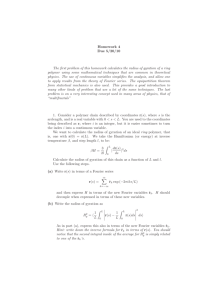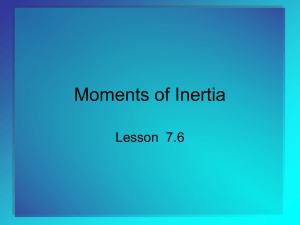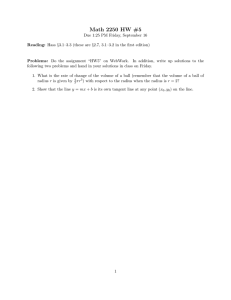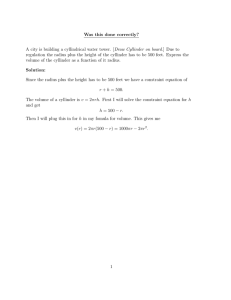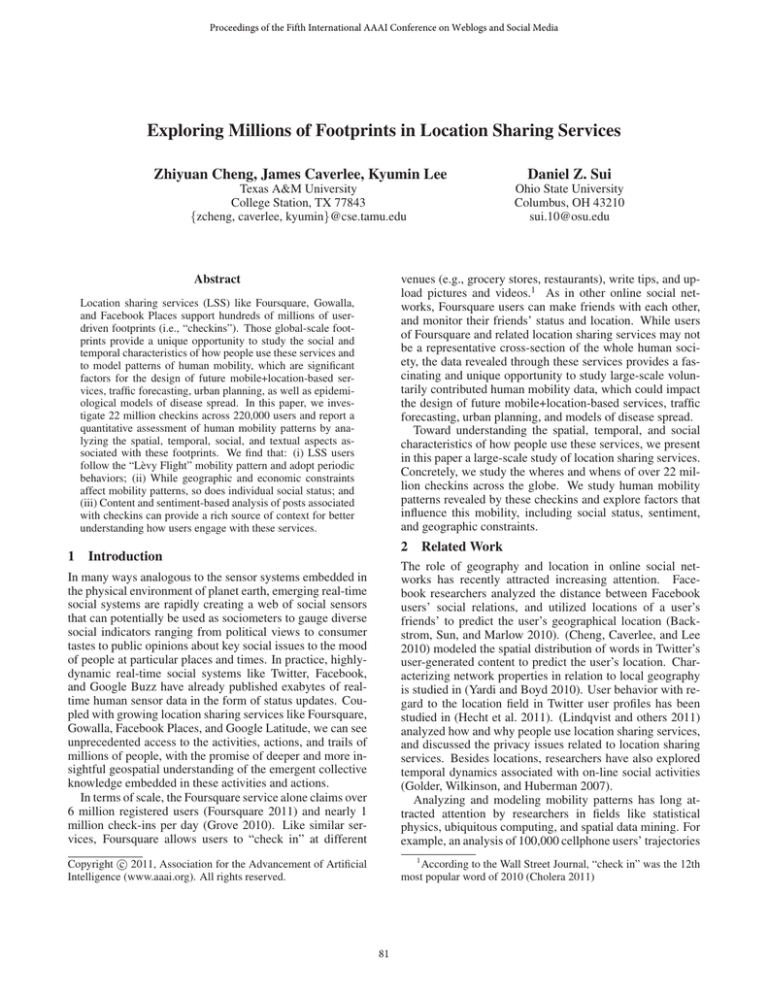
Proceedings of the Fifth International AAAI Conference on Weblogs and Social Media
Exploring Millions of Footprints in Location Sharing Services
Zhiyuan Cheng, James Caverlee, Kyumin Lee
Daniel Z. Sui
Texas A&M University
College Station, TX 77843
{zcheng, caverlee, kyumin}@cse.tamu.edu
Ohio State University
Columbus, OH 43210
sui.10@osu.edu
venues (e.g., grocery stores, restaurants), write tips, and upload pictures and videos.1 As in other online social networks, Foursquare users can make friends with each other,
and monitor their friends’ status and location. While users
of Foursquare and related location sharing services may not
be a representative cross-section of the whole human society, the data revealed through these services provides a fascinating and unique opportunity to study large-scale voluntarily contributed human mobility data, which could impact
the design of future mobile+location-based services, traffic
forecasting, urban planning, and models of disease spread.
Toward understanding the spatial, temporal, and social
characteristics of how people use these services, we present
in this paper a large-scale study of location sharing services.
Concretely, we study the wheres and whens of over 22 million checkins across the globe. We study human mobility
patterns revealed by these checkins and explore factors that
influence this mobility, including social status, sentiment,
and geographic constraints.
Abstract
Location sharing services (LSS) like Foursquare, Gowalla,
and Facebook Places support hundreds of millions of userdriven footprints (i.e., “checkins”). Those global-scale footprints provide a unique opportunity to study the social and
temporal characteristics of how people use these services and
to model patterns of human mobility, which are significant
factors for the design of future mobile+location-based services, traffic forecasting, urban planning, as well as epidemiological models of disease spread. In this paper, we investigate 22 million checkins across 220,000 users and report a
quantitative assessment of human mobility patterns by analyzing the spatial, temporal, social, and textual aspects associated with these footprints. We find that: (i) LSS users
follow the “Lèvy Flight” mobility pattern and adopt periodic
behaviors; (ii) While geographic and economic constraints
affect mobility patterns, so does individual social status; and
(iii) Content and sentiment-based analysis of posts associated
with checkins can provide a rich source of context for better
understanding how users engage with these services.
1
2
Introduction
Related Work
In many ways analogous to the sensor systems embedded in
the physical environment of planet earth, emerging real-time
social systems are rapidly creating a web of social sensors
that can potentially be used as sociometers to gauge diverse
social indicators ranging from political views to consumer
tastes to public opinions about key social issues to the mood
of people at particular places and times. In practice, highlydynamic real-time social systems like Twitter, Facebook,
and Google Buzz have already published exabytes of realtime human sensor data in the form of status updates. Coupled with growing location sharing services like Foursquare,
Gowalla, Facebook Places, and Google Latitude, we can see
unprecedented access to the activities, actions, and trails of
millions of people, with the promise of deeper and more insightful geospatial understanding of the emergent collective
knowledge embedded in these activities and actions.
In terms of scale, the Foursquare service alone claims over
6 million registered users (Foursquare 2011) and nearly 1
million check-ins per day (Grove 2010). Like similar services, Foursquare allows users to “check in” at different
The role of geography and location in online social networks has recently attracted increasing attention. Facebook researchers analyzed the distance between Facebook
users’ social relations, and utilized locations of a user’s
friends’ to predict the user’s geographical location (Backstrom, Sun, and Marlow 2010). (Cheng, Caverlee, and Lee
2010) modeled the spatial distribution of words in Twitter’s
user-generated content to predict the user’s location. Characterizing network properties in relation to local geography
is studied in (Yardi and Boyd 2010). User behavior with regard to the location field in Twitter user profiles has been
studied in (Hecht et al. 2011). (Lindqvist and others 2011)
analyzed how and why people use location sharing services,
and discussed the privacy issues related to location sharing
services. Besides locations, researchers have also explored
temporal dynamics associated with on-line social activities
(Golder, Wilkinson, and Huberman 2007).
Analyzing and modeling mobility patterns has long attracted attention by researchers in fields like statistical
physics, ubiquitous computing, and spatial data mining. For
example, an analysis of 100,000 cellphone users’ trajectories
c 2011, Association for the Advancement of Artificial
Copyright Intelligence (www.aaai.org). All rights reserved.
1
According to the Wall Street Journal, “check in” was the 12th
most popular word of 2010 (Cholera 2011)
81
Table 1: Distribution of Sources of Checkins
Name
Foursquare
UberTwitter
Twitter for iPhone
Twitter for Android
TweetDeck
Gowalla
Echofon
Gravity
TwitBird
Others
Percentage
53.5%
16.4%
10.2%
3.4%
3.1%
2.9%
2.0%
1.3%
1.1%
6.0%
Figure 1: Global Distribution of Checkins
tribution of sources is displayed in Table 1. More than 53%
of the checkins are from Foursquare, and most of the other
checkins are from Twitter’s applications on mobile platforms like Blackberry, Android, and iPhone. A few hundred
thousands checkins are from other location sharing services
like Gowalla, Echofon, and Gravity.
(Gonzalez, Hidalgo, and Barabasi 2008) showed that human
mobility displayed simple reproducible patterns. The authors of (Brockmann, Hufnagel, and Geisel 2006) analyzed
the circulation of bank notes in the US and concluded that
human traveling behavior can be described mathematically
on many spatio-temporal scales by a two parameter continuous time random walk model. A 93% potential predictability
in user mobility was found across 50,000 cellphone users in
(Song et al. 2010). (Zheng and others 2009) proposed a system to mine interesting locations and travel sequences from
users’ GPS trajectories. Researchers of (Humphries and others 2010) observed Lèvy Flight search patterns across 14
species of marine predators, with a few individuals switching between Lèvy Flight and Brownian motion as they traversed different habitat types.
Different from cellphone data and trajectories derived
from GPS trackers, checkins have several unique features:
(i) they are inherently social, since users reveal their location
to their friends, meaning that social structure and its impact
on human mobility can be directly observed; (ii) checkins
are associated with particular venues (e.g., a restaurant), allowing for greater analysis of venue type; (iii) checkins can
be augmented with short messages, providing partial insight
into the thoughts and motivations of users of these services.
3
Format of the Data: Each checkin is stored as the tuple checkin(userID, tweetID) = {userID, tweetID, text,
location, time, venueID}.
An example checkin tuple is: checkin(14091113, 9710376274) = {14091113,
9710376274, “I’m at MTA - Atlantic Ave-Pacific St Subway
Station. http://4sq.com/2nWVD0”, 40.685307, -73.980719,
“2010-02-26 21:42:04”, “cd979d2e352c4f54”}. We additionally store a user as the tuple: user(userID) = {userID,
status count, followers count, followings count}; for the example checkin, the user has 2,771 total status updates, 255
followers and is following 926 users.
Filtering Noise: Many location sharing services provide
some mechanism to verify that a user is actually at or
near the venue where they are checking in (e.g., by crosschecking with a user’s cellphone GPS) (Foursquare 2010),
however, there can still be incidents of false checkins.
Hence, we additionally filter out all checkins from users
whose consecutive checkins imply a rate of speed faster than
1000 miles-per-hour (or faster than an airplane). In total, we
filtered 294 users (0.1%) with sudden moves, yielding a final
collection of 224,804 users and 22,388,315 checkins. More
than 72% users have fewer than 100 checkins; 7.8% users
have more than 300 checkins; and 3.6% users have more
than 500.2
Gathering Checkins
To begin our study, we first require a collection of checkins.
Since personal checkin information on location sharing services like Foursquare, Gowalla, and Facebook Places is typically restricted to a user’s immediate social circle (and hence
unavailable for sampling) we take an approach in which
we sample location sharing status updates from the public Twitter feed. Twitter status messages support the inclusion of geo-tags (latitude/longitude) as well as support thirdparty location sharing services like Foursquare and Gowalla
(where users of these services opt-in to share their checkins on Twitter). We monitor Twitter’s gardenhose streaming
API (∼1% of the entire Twitter public timeline), and retrieve
users who post geo-tagged status updates. For each sampled
user, we crawl up to a maximum of the most recent 2,000
geo-labeled tweets.
The location crawler ran from late September 2010 to late
January 2011, resulting in a total collection of 225,098 users
and 22,506,721 unique checkins. The 22 million checkins
were posted from more than 1,200 applications, and the dis-
Locating Each User’s “Home”: Some of the analysis in
the following sections requires that we first associate each
user with a natural “home”, so, for example, we can compare the properties of all users “from” New York City versus users “from” Los Angeles. Since users of location sharing services are not required to register a home location, we
must algorithmically determine the home location. Note that
choosing a user’s home based on the center of mass of all
checkins suffers from splitting-the-difference, by placing a
user from Houston who occasionally travels to Dallas somewhere in between the two cities; alternatively, directly considering the user’s most frequently checked-in venue may
2
82
Data are available at http://infolab.tamu.edu/data/
Figure 2: Detail: Checkins in the United States
overlook a cluster of closely-located but less individually
checked-in venues. To avoid these drawbacks, we propose
a simple method to geo-locate a user’s home based on a recursive grid search. First, we group checkins into squares of
one degree latitude by one degree longitude (covering about
4,000 square miles). Next, we select the square containing
the most checkins as the center, and select the eight neighboring squares to form a lattice. We divide the lattice into
squares measuring 0.1 by 0.1 square degrees, and repeat the
center and neighbor selection procedures. This process repeats until we arrive at squares of size 0.001 by 0.001 square
degrees (covering about 0.004 square miles). Finally, we select the center of the square with the most checkins as the
“home” of the user.
4
Figure 3: Detail: Checkins in New York City
Spatio-Temporal Analysis of Checkins
Figure 4: Venue Cloud for Checkins
In this section, we begin our study of large-scale location
sharing services with an investigation of the temporal and
geographic characteristics of how people use these services.
4.1
in Figure 5 the mean checkin pattern per day. This pattern
provides a glimpse into the global daily “heartbeat”, with
three major peaks: one around 9am, one around 12pm, and
one around 6pm. The diurnal pattern is clearly displayed as
more people are active during the daytime than at night.
To illustrate the potential of location sharing services as
sociometers of city health and activity, we show in Figure 6, the disaggregated daily checkin patterns of users in
New York City, Los Angeles, and Amsterdam. The checkin
patterns show that Amsterdam’s daily “heartbeat” reflects
an early-rising city, with more activity than either LA or
New York in the morning hours. LA peaks around noon,
whereas New York has the highest checkin rate during the
night (“The City That Never Sleeps”). We are interested to
further explore the reasons for these differences. Are the
daily differences artifacts of local culture? Or the proclivity
of users in certain locations to more willingly reveal certain aspects of their daily lives than others (e.g., checkin in
while at work, but not at play?) Or do the differences reflect
biases in the data, so that certain demographics are overrepresented in one city versus another?
Moving from the daily pattern to the weekly pattern, we
see in Figure 7 the aggregate global patterns over the days of
the week. Weekdays clearly indicate two peaks during lunch
time and dinner time, while over the weekend these two
peaks blend, reflecting a fundamentally different weekend
Wheres of the Checkins
First, we plot the locations of the 22 million checkins in Figure 1, where we see that while checkins are globally distributed, the density of checkins is highest in North America, Western Europe, South Asia, and Pacific Asia. Zooming
in on the US, Figure 2 shows the reach of location sharing
services, revealing the boundaries of cities and the lines of
highways. Further zooming in, we can see in Figure 3 how
New York City is densely covered by more than 12 million
checkins. While these figures convey the scale and density
of location sharing services, we can further explore the nature of these checkins by aggregating keywords across all
22 million checkin tuples. The aggregated view in Figure 4
shows that the most popular checkin venues are restaurants,
coffee shops, stores, airports, and other venues reflecting
daily activity (e.g., fitness, pubs, church).
4.2
Whens of the checkins
Considering the temporal distribution of checkins, we can
uncover both the aggregate daily patterns of users of location sharing services and their weekly patterns. By normalizing the timestamps of every checkin so that all local times
are treated as the same time (i.e., aggregating all checkins
at 1pm, whether they be in Chicago or Tokyo), we show
83
Figure 5: Mean Daily Checkin Pattern
Figure 8: Distribution of Displacements
response, urban planning and agent-based modeling.
5.1
User Displacement
We begin with an investigation of the distance-based displacement of consecutive checkins made by users. Considering all pairs of consecutive checkins yields 22,163,511
separate displacements, reflecting the distance between
these consecutive checkins (and hence, how far a user has
traveled). We plot the distribution of displacement for the
dataset on a log-log scale in Figure 8. The x-axis is the displacement in miles, and the y-axis is the frequency of displacements in the same bucket. The trend is approximated
by a power-law:
Figure 6: Daily Checkin Patterns: NYC, LA, Amsterdam
P (δr ) ∝ δr−β
where δr represents the displacement and β = 1.8845. The
formula indicates that human motion modeled with checkin
data follows a Lévy Flight (Rhee et al. 2008), in which
a random walk proceeds according to steps drawn from a
heavy-tailed distribution. A Lévy Flight is characterized by
a mixture of short, random movements with occasional long
jumps. Flight models with a similar scaling exponent have
been observed separately in a study of displacements based
on cellphone call data with β = 1.75 (Gonzalez, Hidalgo,
and Barabasi 2008) and in a study of displacements based
on bank note dispersal with β = 1.59 (Brockmann, Hufnagel, and Geisel 2006).
Figure 7: Mean Weekly Checkin Pattern
5.2
schedule for most users of location sharing services. We can
also observe that the relative daily activity increases from
Monday to Friday, peaking on Friday evening.
5
Radius of Gyration
Second, we consider the radius of gyration of each user,
which measures the standard deviation of distances between
the user’s checkins and the user’s center of mass. The radius
of gyration measures both how frequently and how far a user
moves. A low radius of gyration typically indicates a user
who travels mainly locally (with few long-distance checkins), while a high radius of gyration indicates a user with
many long-distance checkins. The radius of gyration for a
user can be formalized as:
n
1 (ri − rcm )2
rg = n i=1
Studying Human Mobility Patterns
Given the global coverage of location sharing services and
the potential of user checkins to reveal temporal patterns of
human behavior, we next turn to an examination of mobility patterns reflected in the checkin data. We consider three
statistical properties often used in the study and modeling of
human mobility patterns – displacement, radius of gyration,
and returning probability. Taken together, these properties
can inform whether humans follow simple reproducible patterns, and can have a strong impact on all phenomena driven
by human mobility, from epidemic prevention to emergency
84
Figure 9: Distribution of Radius of Gyration
Figure 10: Mean Radius of Gyration for Users in US Cities
where n is the number of checkins of the user, and (ri −
rcm ) is the distance between a particular checkin ri and the
user’s center of mass rcm (which is a simple average location
over all checkins). We calculate the radius of gyration for
each user in our collection and the distribution of radius of
gyration is displayed on A log-log scale in Figure 9. The xaxis identifies the radius of gyration in miles and the y-axis
shows the number of users with that radius of gyration. The
trend in Figure 9, like the distribution of displacements, also
follows a power-law:
P (rg ) ∝ rg−β
where rg represents the radius of gyration, and β = 0.9864.
34.5% of all users display a radius of gyration of less than
10 miles, while only 14.6% have a radius of gyration larger
than 500 miles.
To illustrate how radius of gyration can give further insight into the dynamics of cities, Figure 10 plots the average
radius of gyration of users in major cities (with 100,000+
population and at least 20 users in the checkin dataset) in
the continental US. The red bubbles are cities with a radius
of gyration larger than 500 miles; blue ones are cities with a
radius larger than 250 miles; cyan ones have a radius larger
than 125 miles, and yellow ones are the rest of major cities.
Users in coastal cities tend to have a higher radius of gyration than users in inland cities, and people in central states
tend to have a high radius of gyration due to long distance
travels to the coasts. Even so, there are some interesting regional variations worth further study, for example, the low
radius of gyration for El Paso compared to the higher radius
for nearby Albuquerque.
5.3
Figure 11: Distribution of Returning Probability
bility that a user returns to a location that she first visited t
hours before. Grouping all returning times of all checkins
into buckets of one-hour, we plot the distribution of returning times in Figure 11, in which the x-axis represents the
bucket of returning time, and the y-axis is the corresponding
frequency for a bucket. For example, at 168 hours, the returning probability peaks, indicating a strong weekly return
probability. Similarly, we see daily return probabilities. As
time moves forward, the returning probability shows a slight
negative slope, indicating the aggregate forgetfulness of visiting previously visited places (that is, the return probability
is strongest for places we have visited most recently).
6
Exploring Factors that Influence Mobility
In this final section, we turn our attention to exploring the
factors that may impact human mobility. While factors like
geography and economic status are natural to investigate, the
unique properties of location sharing services provide an unprecedented opportunity to consider heretofore difficult to
measure aspects of human behavior. For example, does social status as measured through popularity in these services
impact a user’s radius of gyration? Does user-generated content implicitly reveal characteristics of the mobility of users?
Returning Probability
The third property we study – returning probability – is a
measure of periodic behavior in human mobility patterns.
Periodic behavior is common in people’s daily life (e.g., visits to work or school every weekday; visits to the grocery
store on weekends) and echoes periodic behavior observed
in animal migrations when animals visit the same places at
the same time each year. Do users of location sharing services display a similar periodicity?
We measure periodic behavior by the returning probability (or, first passage time probability), which is the proba-
6.1
Geographic and Economic Constraints
We begin by illustrating how geographic and economic constraints can influence human mobility patterns as revealed
by location sharing services. We focus on users who are lo-
85
Figure 12: Average Rg versus City Population Density
Figure 14: Average Rg versus Popularity
Figure 13: Average Rg versus City Avg Household Income
Figure 15: Average Rg versus Social Status
cated in US cities with a population of more than 4,000. As
one type of geographic constraint we consider population
density and compare the radius of gyration for users from
cities of differing density.3
As shown in Figure 12, we can clearly see that people in
the densest areas travel much more than people in sparse areas, but that people in the sparsest areas travel farther than
people in slightly denser areas. One possible explanation
for both of these observations can be that: people living
in metropolitan areas have more opportunities to travel for
business to distant cities or countries; and people living in
sparse areas (small towns) require longer travel to nearby
mid-size cities.
Similarly, we can examine the economic properties of a
city to understand whether economic capacity inhibits or
encourages more travel by its residents. Specifically, we
measure the influence of a city’s average household income
on its residents’ radius of gyration, which is plotted in Figure 13. The figure shows that people in wealthy cities travel
more frequently to distant places than people in less rich
cities. In the meantime, people in cities with the least incomes travel slightly more than people in richer cities.
What is encouraging about both these example observations is that location sharing services provide a new window
for measuring and studying fundamental properties of cities
and their residents.
3
6.2
Social Status
We next turn to one of the more exciting possibilities raised
by the social structure inherent in location sharing services.
Does social status impact human mobility? We consider
two simple measures of status. The first is a simple measure of popularity, where we count the user’s number of followers from their Twitter profile (recall the data collection
method described earlier in the paper; followers are onesided friendships). The second is a measure of status that
considers the ratio of a user’s number of followers to the
number of users that the user follows (followings):
nf ollowers (u)
nf ollowings (u)
High-status users have many followers but follow very
few other users themselves. Figure 14 and Figure 15 show
the relationship between both of these social status factors
and the radius of gyration. We see that in both cases highly
social users have higher radii of gyration than less social
users. Our initial hypothesis is that users who travel have
more chances to meet friends, and thus get involved in more
social activities. But perhaps users with lower measured
“status” engage with these social media technologies differently? For example, some Twitter users may primarily only
follow other users as a form of news gathering, rather than
treating Twitter as a social network of friends, resulting in
lower measured status. We are interested to explore these
and related questions in our ongoing research.
status(u) =
Data for each US city is parsed from www.city-data.com.
86
6.3
Content and Sentiment Factors
Finally, we turn to an analysis of user-generated content in
location sharing services and its impact on mobility. Users
of location sharing services, in addition to recording their
location, can also post short messages, tips, and other annotations on the locations they visit. Unlike purely GPS-driven
or cellphone trace data, these short messages provide a potentially rich source of context for better understanding how
users engage with location sharing services.
Significant Terms vs. Radius of Gyration: Our first goal is
to identify significant terms for users associated with varying degrees of radius of gyration, much like in our previous
studies of economic, geographic, and social factors. Do high
mobility users describe the world differently than low mobility users? We focus our study here on English-language
messages only by using the language identification component in the NLTK toolkit (Loper and Bird 2002). We find
that 49% of all users (110,559) in our collection are primarily English-language users.
To identify significant terms for these users, we identify
terms with high mutual information for each category of radius of gyration. Mutual information is a standard information theoretic measure of “informativeness” and, in our case,
can be used to measure the contribution of a particular term
to a category of radius of gyration. Concretely, we build a
unigram language model for each category of radius of gyration by aggregating all posts by all users belonging to a
particular category of radius of gyration (e.g, all users with
a radius of gyration between 0 and 10). Hence, mutual information is measured as: M I(t, c) = p(t|c)p(c)log p(t|c)
p(t)
where p(t|c) is the probability that a user which belongs to
category c has posted a message containing term t, p(c) is
the probability that a user belongs to category c, and p(t) is
the probability of term t over all categories. That is, p(t) =
count(t)/n. Similarly, p(t|c) and p(c) can be simplified as
p(t|c) = count(c, t)/count(c) and p(c) = count(c)/n respectively, where count(c, t) denotes the number of users in
category c which also contain term t, and count(c) denotes
the number of users in category c.
In Table 2, we report the top-10 most significant terms
from users with different radii of gyration. In the table, we
can clearly see the differences between frequent travelers
with a large radius of gyration and the more local people
with a small radius of gyration. Travelers talk a lot about
long journey related terms: “international airport” (and abbreviations of international portals: “SFO”, “JFK”), major
metropolitan areas (e.g., New York, San Francisco, London,
Paris, Los Angeles), “flight”, and “hotel”. At lower levels of
mobility, we see significant words like “railway station” and
“bus”, as well as discussion of “home”, “work”, “church”,
grocery stores (e.g., HEB, Walmart, “mall”), “college”, and
“university”. People with different mobility patterns significantly differ in the topics they talk about and terms they use,
indicating a fruitful area of further study.
Figure 16: Frequency of Users in Categories of Sentiment
Table 3: Top-10 Significant Terms for Sentiment Category
Sentiment
(0.1, 1.0]
(−0.1, 0.1]
[−1.0, −0.1]
good
thanks
ave
road
not
damn
like
great
mayor
blvd
hate
wrong
Top 10 Terms
love
lol
haha
awesome
street
New York
airport
center
bad
f**k
hell
stupid
well
nice
park
home
s**t
hiv
capture the sentiment associated with the checkins, we use
the public SentiWordNet (Esuli and Sebastiani 2006) thesaurus to quantify sentiment for each English speaking user.
For each message, we extract the words that have a quantified sentiment value in SentiWordNet and consider the sentiment of the post as the mean value for the sentiments for
words in the post. For each user, the user’s sentiment is calculated as the mean value of the sentiments of all the user’s
posts. In this way, we capture the sentiment for each of the
110,559 English speaking users in the dataset. The distribution of sentiment of the users is plotted in Figure 16, and we
can clearly see that most users have a neutral sentiment, and
only a small portion of users express strong sentiment when
using location sharing services.
When we drill down to see which words are associated
with a positive, neutral, and negative sentiment (again, using mutual information) we see in Table 3 that most of the
top neutral terms are likely to be extracted from the autogenerated checkins. In the two categories with non-neutral
sentiment, we can clearly see typical words which indicate
strong positive and negative sentiment.
However, when we filter the top-100 most positive and
most negative terms to only consider location-related terms,
we find that there are no location-specific positive terms, but
there are many location-specific negative terms. Examples
of the words are listed in Table 4. On further inspection of
the messages containing these words, we can clearly see the
strong negative sentiment associated to the content. For example, when people talk about “MTA”, they complain a lot
about price increases of MTA’s tickets, and its poor service
(e.g., “Ticket to the country home has increased by $3. NJTransit is worse than the MTA! (@ New York Penn Station
w/ 23 others)”, and “I know the MTA is a disaster but 2 of 4
machines being unable to read credit cards at AirTrain station is a new low.”). This preliminary analysis indicates that
Capturing User’s Sentiment: We can additionally measure
the relative viewpoint of users and their locations by considering the sentiment of each user’s posted messages. To
87
Table 2: Top 10 Significant Terms for Each Radius of Gyration Rg Category
Rg (miles)
(1000,+∞)
(500,1000]
(300,500]
(100,300]
(50,100]
(10,50]
(0,10]
international airport
SFO
international airport
Chicago
international airport
Lake
airport
Berlin
mayor
church
mayor
house
Singapore
center
Top 10 Terms
New York
San Francisco
flight
JFK
San Francisco
New York
hotel
Seattle
Chicago
Dallas
Austin
Beach
Chicago
Atlanta
church
center
railway station
Pittsburgh
Madrid
Greenville
station
home
HEB
school
home
Jakarta
mall
bus
terminal
Paris
Los Angeles
Washington
hotel
Seattle
hotel
beach
Stockholm
college
Bangkok
road
university
road
Foursquare. 2010. Cheating, and claiming mayorships from your
couch. http://blog.foursquare.com/2010/04/07/503822143/.
Foursquare.
2011.
So we grew 3400% last year.
http://blog.foursquare.com/2011/01/24/2010infographic/.
Golder, S. A.; Wilkinson, D. M.; and Huberman, B. A. 2007.
Rhythms of social interaction: Messaging within a massive online
network. In Proceedings of the Third Communities and Technologies Conference.
Gonzalez, M. C.; Hidalgo, C. A.; and Barabasi, A.-L. 2008.
Understanding individual human mobility patterns.
Nature
453(7196):779–782.
Grove, J.
2010.
Foursquare nearing 1 million checkins
per day (mashable). http://mashable.com/2010/05/28/foursquarecheckins/.
Hecht, B.; Hong, L.; Suh, B.; and Chi, E. H. 2011. Tweets from
justin biebers heart: the dynamics of the location field in user profiles. In SIGCHI ’11.
Humphries, N. E., et al. 2010. Environmental context explains
Lévy and Brownian movement patterns of marine predators. Nature 465(7301):1066–1069.
Lindqvist, J., et al. 2011. I’m the mayor of my house: Examining why people use foursquare - a social-driven location sharing
application. In SIGCHI ’11.
Loper, E., and Bird, S. 2002. NLTK: the Natural Language Toolkit.
In Proceedings of the ACL-02 Workshop on Effective tools and
methodologies for teaching natural language processing and computational linguistics.
Rhee, I.; Shin, M.; Hong, S.; Lee, K.; and Chong, S. 2008. On the
Levy-Walk nature of human mobility. In INFOCOM ’08. IEEE.
Song, C.; Qu, Z.; Blumm, N.; and Barabasi, A.-L. 2010. Limits of
Predictability in Human Mobility. Science 327(5968):1018–1021.
Yardi, S., and Boyd, D. 2010. Tweeting from the town square:
Measuring geographic local networks. In ICWSM ’10.
Zheng, Y., et al. 2009. Mining interesting locations and travel
sequences from GPS trajectories. In WWW ’10.
Table 4: Top-20 Location Terms with Negative Sentiment
MTA
Jersey
Redmond Memphis
Winooski Ridgewood
Toronto
Greece
Chicago
Cleveland
Calgary
Scottsdale
Beaumont Petersburg
Ashburn
Buffalo
Richmond
Montreal
Durham
Eugene
users are more likely to express negative sentiment about location, and that locations and location-related concepts associated with negative sentiment can be automatically identified based on location sharing services.
7
London
Jakarta
Las Vegas
terminal
New York
Orlando
Jakarta
bar
university
center
work
Walmart
Indonesia
woodlands
Conclusion
In this paper, we provide a large-scale quantitative analysis and modeling of over 22 million checkins of location
sharing service users. Concretely, three of our main observations are: (i) LSS users follow simple reproducible patterns; (ii) Social status, in addition to geographic and economic factors, is coupled with mobility; and (iii) Content
and sentiment-based analysis of posts can reveal heretofore
unobserved context between people and locations. As future
work, we are interested to further explore the social structure
inherent in location sharing services to study group-based
human mobility patterns (e.g., flock behavior). We are also
interested in personalized location recommendation based
on checkin history and friend-based social mining.
References
Backstrom, L.; Sun, E.; and Marlow, C. 2010. Find me if you can:
improving geographical prediction with social and spatial proximity. In WWW ’10.
Brockmann, D.; Hufnagel, L.; and Geisel, T. 2006. The scaling
laws of human travel. Nature 439(7075):462–465.
Cheng, Z.; Caverlee, J.; and Lee, K. 2010. You are where you
tweet: A content-based approach to geo-locating twitter users. In
CIKM ’10.
Cholera, R.-S. 2011. Words of the year 2010 (the wall street journal). http://on.wsj.com/e7AyTt.
Esuli, A., and Sebastiani, F. 2006. SENTIWORDNET: A Publicly
Available Lexical Resource for Opinion Mining. In In Proceedings of the 5th Conference on Language Resources and Evaluation
(LREC’06).
88

